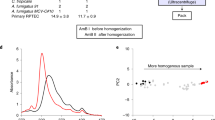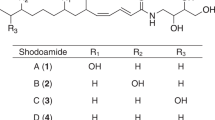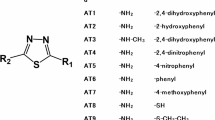Abstract
A novel series of conjugates of the antifungal antibiotic amphotericin B (AmB) with benzoxaboroles was synthesized. Antifungal activity of new compounds was tested on yeastβ Candida albicans and Cryptococcus humicolus and filamentous fungi Aspergillus niger and Fusarium oxysporum using the broth microdilution method. The potency of di-modified derivatives against the tested strains was similar to that of the parent AmB. New derivatives demonstrated differential toxicity against human cells (colon epithelium or red blood cells). The di-modified conjugate 2-(N,N-dimethylamino)ethylamide of 3′-N-[3-(1-hydroxy-1,3-dihydrobenzo[c][1,2]oxaborol-7-yl)propanoyl] AmB (9) showed the best combination of a high antifungal activity with a low cytotoxic and hemolytic potency.
Similar content being viewed by others
Log in or create a free account to read this content
Gain free access to this article, as well as selected content from this journal and more on nature.com
or
References
Ceregeghetti, D. M. & Carreira, E. M. Amphotericin B: 50 years of chemistry and biochemistry. Synthesis 6, 914–942 (2006).
Solovieva, S. E., Olsufyeva, E. N. & Preobrazhenskaya, M. N. Chemical modification of antifungal polyene macrolide antibiotics. Russ. Chem. Rev. 80, 103–126 (2011).
Preobrazhenskaya, M. N. et al. Synthesis and study of the antifungal activity of new mono- and di-substituted derivatives of a genetically engineered polyene antibiotic 28, 29-didehydro nystatin A1 (S44HP). Novel water-soluble derivative active in the model of the candidosis sepsis in leucopenic mice. J. Antibiot. (Tokyo) 63, 55–64 (2010).
Tevyashova, A. N. et al. Structure-antifungal activity relationships of polyene antibiotics of the Amphotericin B group. Antimicrob. Agents Chemother. 8, 3815–3822 (2013).
Adamczyk-Woźniak, A., Borys, K. M. & Sporzyński, A. Recent developments in the chemistry and biological applications of benzoxaboroles. Chem. Rev. 115, 5224–5247 (2015).
Dembitsky, V. M., Quntar, A. A. & Srebnik, M. Natural and synthetic small boron-containing molecules as potential inhibitors of bacterial and fungal quorum sensing. Chem. Rev. 111, 209–237 (2011).
Baker, S. J. et al. Discovery of a new boron containing antifungal agent, 5-fluoro-1,3-dihydro-1-hydroxy-2,1- benzoxaborole (AN2690), for the potential treatment of Onychomycosis. J. Med. Chem. 49, 4447–4450 (2006).
Baker, S. J., Tomsho, J. W. & Benkovic, S. J. Boron-containing inhibitors of synthetases. Chem. Soc. Rev. 40, 4279–4285 (2011).
Rock, F. L. et al. An antifungal agent inhibits an aminoacyl-Trna synthetase by trapping tRNA in the editing site. Science 316, 1759–1761 (2007).
Printsevskaya, S. S. et al. Synthesis and study of antibacterial activities of antibacterial glycopeptide antibiotics, conjugated with benzoxaboroles. Future Med Chem 5, 641–652 (2013).
Qiao, Z. et al. Chalcone–benzoxaborole hybrid molecules as potent antitrypanosomal agents. J. Med. Chem. 55, 3553–3557 (2012).
Brown, J. M. & Sidebottom, P. J. The proton magnetic resonance spectrum of amphotericin B. Tetrahedron 37, 1421–1428 (1981).
Volpon, L. & Lancelin, J.-M. Solution NMR structure of five representative glycosylated poly macrolide antibiotics with a sterol-dependent antifungal activity. Eur. J. Biochem. 269, 4533–4541 (2002).
National Committee for Clinical Laboratory Standards Reference Method for Broth Dilution Antifungal Susceptibility Testing of Yeasts: Approved Standard M27-A, National Committee for Clinical Laboratory Standards, Wayne, PA, USA, (1997).
Clinical and Laboratory Standards Institute Reference Method for Broth Dilution Antifungal Susceptibility Testing of Yeasts: In Third International Supplement CLSI M27-S3, Clinical and Laboratory Standards Institute, Wayne, PA, USA, (2013).
National Committee for Clinical Laboratory Standards Reference Method for Broth Dilution Antifungal Susceptibility Testing of Conidium-Forming Filamentous Fungi: Approved Standard M38-A, NCCLS, Wayne, PA, USA, (2002).
Clinical and Laboratory Standards Institute Reference Method for Broth Dilution Antifungal Susceptibility Testing of Filamentous Fungi: In Approved Standard, 2nd edn CLSI M38-A2 (Clinical and Laboratory Standards Institute, Wayne, PA, USA, 2008).
Preobrazhenskaya, M. N. et al. Chemical modification and biological evaluation of new semisynthetic derivatives of 28,29-didehydronystatin A1 (S44HP), a genetically engineered antifungal polyene macrolide antibiotic. J. Med. Chem. 52, 189–196 (2009).
Nicolaou, K. C. et al. Chemistry of amphotericin B. Degradation studies and preparation of amphoteronolide B. J. Am. Chem. Soc. 10, 4660–4672 (1988).
Mahalingam, A., Geononnoty, A., Balzarini, J. & Kiser, P. F. Activity and safety of synthetic lectins based on benzoboroxole-functionalized polymers for inhibition of HIV entry. Mol. Pharm. 8, 24–2475 (2011).
Delaglio, F. et al. NMRPipe: a multidimensional spectral processing system based on UNIX pipes. J. Biomol. NMR 6, 277–293 (1995).
Goddard, T. D. & Kneller, D. G. Sparky–NMR Assignment and Integration Software (2008). http://www.cgl.ucsf.edu/home/sparky. Accessed on 06 March 2016.
Acknowledgements
We are grateful to Natalia M Malyutina (Gause Institute of New Antibiotics, Moscow) for HPLC analyses. This study was supported by the Russian Foundation for Basic Research grants 13-03-00643-a and 16-34-60110. NMR studies were partly supported by the Russian Science Foundation grant 14-14-00598.
Author information
Authors and Affiliations
Corresponding authors
Ethics declarations
Competing interests
The authors declare no conflict of interest.
Additional information
Supplementary Information accompanies the paper on The Journal of Antibiotics website
Supplementary information
Rights and permissions
About this article
Cite this article
Tevyashova, A., Korolev, A., Trenin, A. et al. New conjugates of polyene macrolide amphotericin B with benzoxaboroles: synthesis and properties. J Antibiot 69, 549–560 (2016). https://doi.org/10.1038/ja.2016.34
Received:
Revised:
Accepted:
Published:
Issue date:
DOI: https://doi.org/10.1038/ja.2016.34
This article is cited by
-
Experimental Evaluation of Chronic Toxicity of Amphamide – a New Semisynthetic Derivative of Amphotericin B
Pharmaceutical Chemistry Journal (2020)
-
Development of a Parenteral Medicinal Formulation of the New Antifungal Semisynthetic Polyene Antibiotic Amphamide
Pharmaceutical Chemistry Journal (2020)
-
Oxaborine Derivatives: Synthesis and Therapeutic Potential
Chemistry of Heterocyclic Compounds (2020)
-
Preclinical Pharmacokinetics Study of Amphamide: a New Semisynthetic Antifungal Antibiotic
Pharmaceutical Chemistry Journal (2020)
-
Synthesis and evaluation of biological activity of benzoxaborole derivatives of azithromycin
The Journal of Antibiotics (2019)



